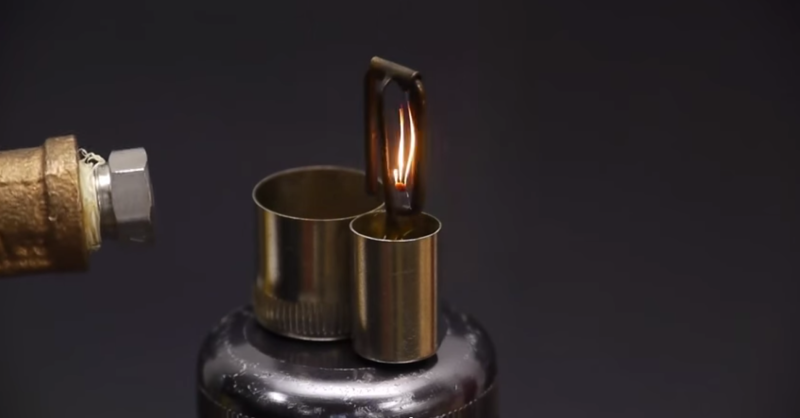[Ben Krasnow] has an inimitable knack for choosing the most interesting concepts for his experiments. We’re sure it’s a combination of base knowledge and epic-curiosity. This time around he’s showing off a vintage cigarette lighter whose quirk is not needing to be “struck” to produce a flame. It’s a catalytic lighter that uses platinum to ignite methanol vapors.
The concept shown in the video below is platinum’s catalyst properties with some types of flammable gasses. The image above shows the cap of the lighter which includes a protective cage around a hunk of fine platinum powder known as platinum black. It is suspended by platinum wire and as the hydrogen passes by the reaction causes the platinum black and wire to glow red-hot.
This simple, quick experiment fills in our own knowledge gaps. We were already familiar with the role that catalytic converters play in automobiles; consuming any unburned hydrocarbons before they exit a vehicle’s exhaust system. We also know the these devices are targets for thieves seeking the platinum (and other metals like palladium and rhodium) found inside. Now we know exactly how catalytic converters work and the integral role that platinum plays in the process. All thanks to [Ben’s] demonstration of how this lighter works.
Now, if you wear a platinum wedding band and your hand passes a jet of hydrogen are you likely to get burned?















I’m guessing the larger mass and diameter of the platinum of a wedding ring would conduct heat away, and not reach combustion temperature.
But you didn’t say how large of a jet it would be…
I suspect the platinum in jewelry is alloyed for strength and scratch resistance.
quick google and a few jewelers say Pt jewelry ranges from ‘cheap’ alloys of 58.5% Pt the remainder being Cu and Co. To 90% pure Pt in expensive pieces.
I wonder how pure the plating must be in order to catalyze reactions.
Also surface area of a smooth ring would be very small compared to the platinum black powder.
This. Catalytic coatings are very craggy, made to have maximal surface area. A polished ring is the exact opposite.
It might get at least noticeably warm. Or not. Anyone care to check? ;)
And I’ve never seen self-lighting devices of this type before. So thanks for featuring this. I love newly discovering old tech.
I bet if you had a real nice stream of hydrogen gas you could get it to warm up nicely.
If you had a really nasty stream of hydrogen gas (say around 4100K) you could get it to heat up quite nastily. Then vaporize.
STP, I think the best you could hope for was a little mosture.
Could (or has anyone ever) use(d) this to ignite a rocket motor?
Yes.
The Germans used silver mesh to catalytically decompose hydrogen peroxide in the Me-163. There are/were a number of torpedos that used hydrogen peroxide as the main fuel to spin turbines. A few WWII/cold war era subs sank due to fires in the armory when the fuel ignited in the sub.
so, like the Bell Rocket Belt…
http://en.wikipedia.org/wiki/Bell_Rocket_Belt#Operating_principle
Compressed nitrogen displaces liquid hydrogen peroxide,which is piped to the gas generator. There it contacts the catalyst (thin silver plates, covered with a layer of samarium nitrate) and decomposes.The resulting hot high-pressure mixture of steam and oxygen gas enters two pipes, which emerge from the gas generator.
Everything you could want to know in 45s about the history of peroxide rocket motors.
http://en.wikipedia.org/wiki/High-test_peroxide
Not just Cold War submarines. Russia lost a submarine during a training exercise in 2000 due to a peroxide-powered torpedo leaking fuel.
This is out of print, but if you’re resourceful, there are ways to find a copy. It’s an amazing read.
http://www.amazon.com/Ignition-informal-history-liquid-propellants/dp/0813507251
Aww he breaks the wire at 1:50
Are these still made? Technically, I was looking for a lighter that would light instantly in extremely cold temperatures. And this popped up, but I’m not sure if this is OK to light a cigarette or if this is just an emergency lighter type of thing.